« February 2014 |
Main
| April 2014 »
 March 27, 2014 | Mandolin Perspective
March 27, 2014 | Mandolin Perspective
Those who intensely devour mandolin news and participate in mandolin discussion boards, let alone invest hours into practicing the mandolin probably have a slightly distorted perception of how significant the instrument is in the world of music. The following graphic is a picture that tells a thousand words about our place.
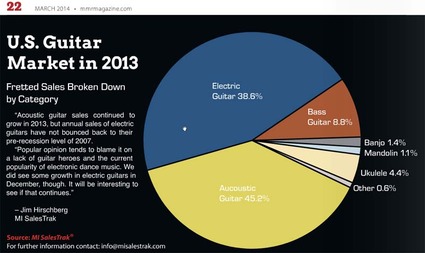
Click for closeup
The information is from US trade industry data (MI Sales Trak) on how fretted instrument sales are broken down by instrument, electric & acoustic guitar, banjo, uke, mandolin, and "other." Note our little 8-string wonder is a paltry 1% of the entire market. We see this as good news/bad news.
First the bad. All the wallowing in self-pity about the lack of option for niche product like our desire for flatwound strings for lower mandolin family instruments (dola, octave, etc.) and cheap mandola cases. This is why. With electric guitar sales a 45 times the mandolin, why wouldn't their be 45 times the choice? Simple market economics.
And all the feelings of oppression when our "little guitar" is mistaken for any number of other instruments, when the guitar is 83 times a popular in sales, we should rejoice at recognition and expect the masses to not know what's in that little violin-shaped case.
Now the good news. Growth. Simple opportunity. If you show up at a jam with a dozen guitar players, there is an attraction to a sound that is unique.
Many of us a former frustrated guitar players, and we're drawn to the mandolin simply because the field was less crowded. There's a lot of room for growth out there, jazz (duh), pop music, praise band, but we have to think the instrument differently. We need to do what it does better than other instruments, fret mobility, tremolo, cross picking, chop, and run with it.
Further
Guitar to mandolin
Complements of you...
Plays Well With Others...
A common mistake. Clacky, clacky...
What's a mandolin sound like?
Posted by Ted at 9:01 AM
 March 20, 2014 | Best of JM: Vamps. Circle of fifths
March 20, 2014 | Best of JM: Vamps. Circle of fifths
Enjoy the popular archive material below.
From Sept 20, 2012 | Vamps. Circle of fifths
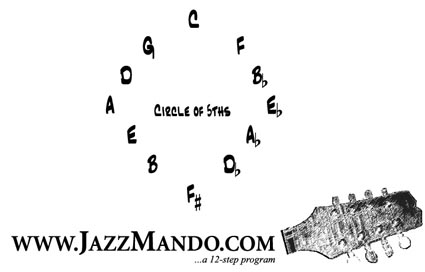
We're now on our fourth of a five-part series on 3-note vamping chords. We started simple with triads, moved to embellishing/passing chords, and dipped our toes into dominants last week, but this time we want to exploit a common music theory concept discussed many times before, the circle of 5ths. As we uncovered last week, you can do a lot to propel the harmonic progression of any song with a V7 chord, even add some that weren't there in the first place. We did this with a simple diatonic progression:

Note we took the ii chord of D (Em) and inserted its dominant, the B7. This time we want to take the V7 of the V chord, E7 and replace the Em:
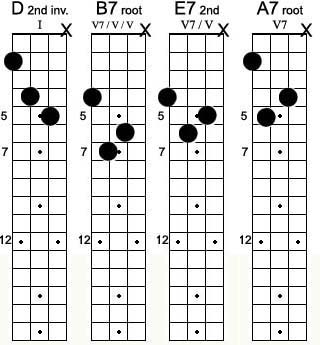
Subtle point: In shorthand, many will refer to this as a major II (II7) chord, but that's technically incorrect, as the two chord of the major scale is not major. As we've demonstrated in this series, we want to think functionally, not just what the chord is, but what it's doing. In this case, it is modifying the A7 chord (V7), so the reason we call it the V7 of V (V7 / V) is to imply purpose. It may seem a long way to go around it, but ultimately, the goal is to give you a harmonic tool you can repeat and use in other keys!
Continue with the other inversions up the neck:
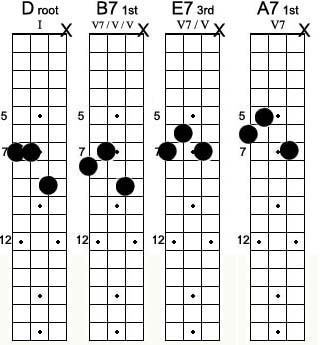
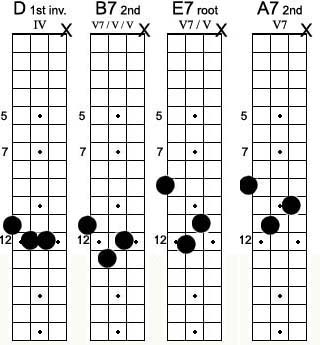
Now, even though we are in the key of D, let's take this one step further and demonstrate what is commonly called a Turnaround. We're going to take the V7 of the V of V (F#7). A lot of jazz is thinking backwards. Take your destination home key (D) V7 (A7). A step before that is the V7 of V (E7) we've already blocked. Now rather than use the tonic key D, let's inject the V7 of the V of V (V7 / V / V), F#7.
VII7 or V7/V/V ?
Again, some might call the F#7 the VI7, in the key of D, but we still want to imply function. We're on a "secondary" Dominant Journey, and as we mentioned earlier, we're traveling the Circle of 5ths:
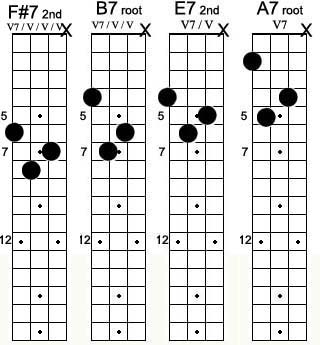
Note, even though there is no D chord in this block you are still implying "D-ness" by ending it on the A7, the V7 chord. A D major will follow it all nicely!
Blocking out the other inversions for you:
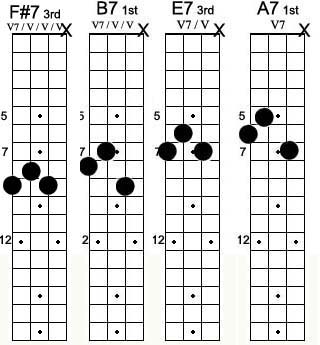
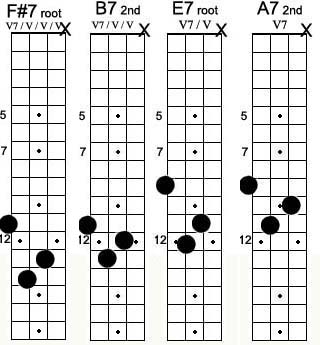
Notice how smooth the voicing is on these, minimal movement fret to fret. Even if you didn't intellectually grasp the "science" in all this, you have to admit it's a pretty cool sound.
Further
Vamps. Creating energy with Diatonic triads
Vamps. Expanding the Diatonic triads
Vamps. Scurry Dominants
Secondary Dominants
Functional thinking...
Posted by Ted at 9:08 AM
 March 13, 2014 | Again. Fingers/Ears/Brain
March 13, 2014 | Again. Fingers/Ears/Brain
If you've been a reader here for a while, you're probably already familiar with our approach to learning the concepts we tackle. We believe that higher level intellectual process are most effectively learned through the physical. When you learned your fist chord, maybe a G major, your placed your fingers where the diagram showed you and you stamped it in your brain as "G chord." You learned another, maybe a D7, and you learned how to move from one to the next.
You probably learned to associate the names of the notes on the fretboard as you placed your fingers on the strings, and organized them intellectually by scale. After they became intuitive, you didn't think so much individual note, but groups. You learned chord "progression." When you developed a chord and scale vocabulary, this became your way of thinking, but it all started with something physical. Later it was reinforced by your ear--"I'm on the right note/chord because it sounds right."
The essence of FFcP was to develop your fingers and embed deeper music theory notions that would reveal themselves later as you improve in flexibility and control. Some have been confused by the extra notations we put in the exercises, harmonic analysis and terms like "guide tones" or "contrary motion." We encourage you to ignore them and treat the exercises like calisthenics for now.
If you stuck it out, you became ready to understand what you were playing after several weeks. We call this "Finger. Ears. Brain."
The philosophy of Fingers to Ears to Brain was the cornerstone of the Getting Into Jazz Mandolin book, and we tried to be consistent with that separating archived articles into titles under these distinctions, although there is obvious crossover.
1.) develop your fingers to find the correct notes, 2.) develop your ear to hear the notes your fingers play, 3.) develop your brain to comprehend the musical style and theory.
Our site archives have been indexed this way:
Fingers
Ears
Brain

Enjoy the journey!
Posted by Ted at 11:07 AM
 March 6, 2014 | Reviewing Scurry Dominants
March 6, 2014 | Reviewing Scurry Dominants
Straight out of "Play now--understand later," we go back to the 3rd of a 5-part series on Vamps we posted in 2012. We had the series repeated in the Mandolin Cafe Lessons page, as well, but for now, just play through the chords. Get familiar with them and try transposing them.
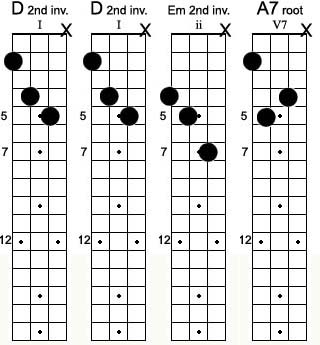
All we are doing is adding a 'ii V7' to the I. Repeat these over and over, you get the "Vamp" effect we've been studying. It's far more interesting than the I, I, I, I voice (yawn...) you might do if all the music called for was a D chord.
Take a look at other fretboard incarnations of the V7 chord:
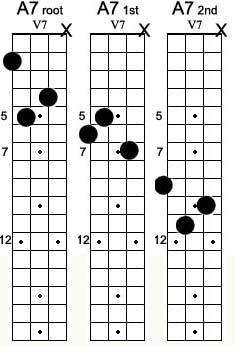
We can inject these into other voicings of the 'I ii V7' in D:
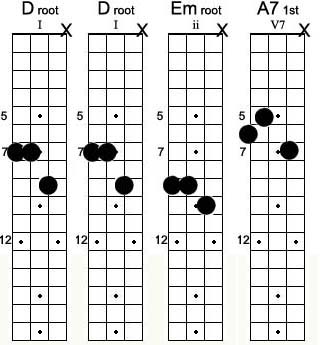

Again, you can transpose these blocks all over the fretboard in other keys. Try moving everything up a fret. Makes playing in the key of Eb a snap!
Remember, we're sneaking the V7 where it wasn't before. Playing it fast, a sort of "scurry" dominant, you can inject the V7 chord just about anywhere in a song. Get in--get out. We going to take the trick one step farther and add the V7 of the ii chord, the B7, injecting the B7 blocks.
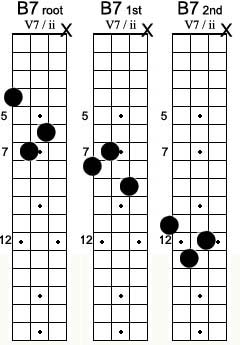
We'll add this to the progression, and note if you scurry this, it still balances spice with the integrity of the home key.

Add this to the other inversions:
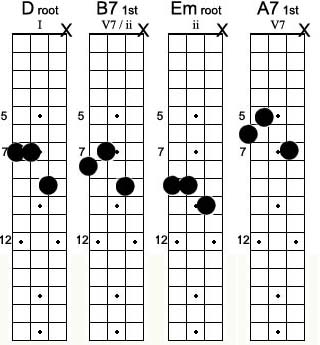
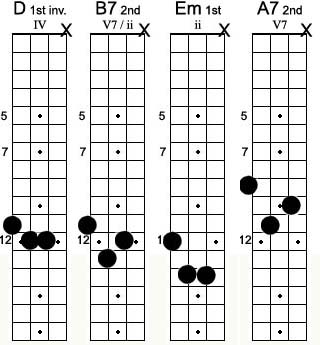
We mentioned moving it up a fret to apply in the key of Eb. Now you can go all over the place with these. Does the progression sound familiar? (Check out the chords for "I've Got Rhythm.") You'll find this all over the place, and don't limit yourself to places where it's written out.
Season to taste.
Further
Vamps Pt 1. Creating energy with Diatonic triads
Vamps Pt 2. Expanding the Diatonic triads
Vamps Pt 3. Scurry Dominants
Vamps Pt 4. Circle of fifths
Vamps Pt 5. Minor Modal
Posted by Ted at 11:11 AM

Disclaimer: In the 'Information Age' of the 21st Century,
any fool with a computer, a modem, and an idea can
become a self-professed 'expert." This site does not
come equipped with 'discernment.'
|



